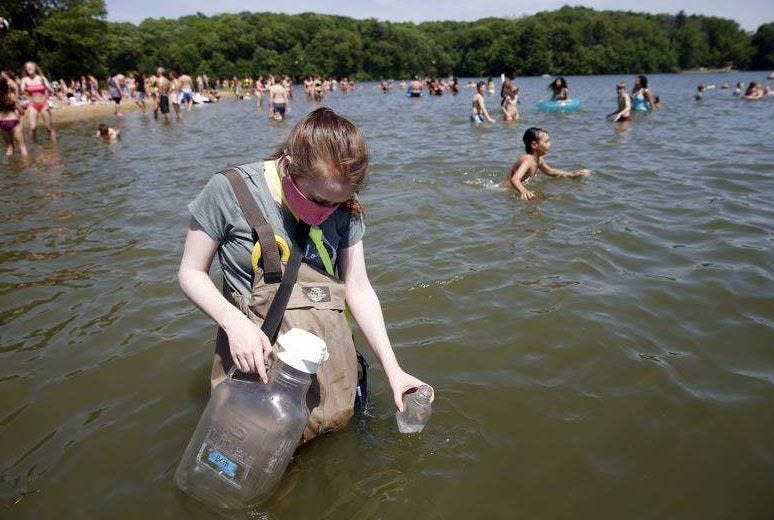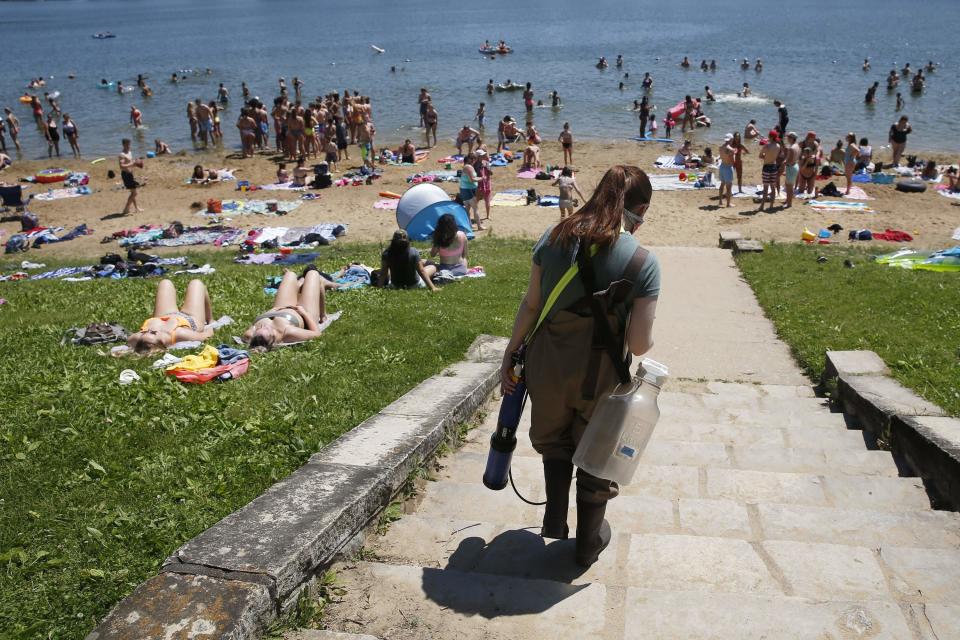Swimming not recommended at these 11 Iowa beaches due to high bacteria levels, DNR says

Swimming is not recommended at 11 state park beaches in Iowa because of high bacterial levels, according to the state's Department of Natural Resources. A 12th was closed as a precaution earlier this mont after a swimmer was infected by a "brain-eating amoeba."
Officials at Iowa's Department of Natural Resources collect weekly samples of the state-owned swimming beaches each summer to determine if the public is at risk of contracting waterborne diseases if they go into the water.
The state agency works with various public health and management agencies throughout the state to inform the public of the most current water quality conditions.
The latest conditions, which were updated Friday, include 11 beaches across the state in the agency's "swimming not recommended" category. One of them, Big Creek Beach, is located near Saylorville Lake, about 20 miles from Des Moines.
In 2021, 24 of the 38 DNR-monitored beaches recorded swim advisories over the summer, according to the Iowa Environmental Council, a nonprofit environmental advocacy coalition that tracks such notices. There were a total of 88 E. coli advisories and 23 microcystin advisories across the affected beaches.
Since 2014, Backbone Beach has experienced the most E.Coli advisories — 105 — of any state beach, according to the council. Last year, the beach was under advisory for 11 of the 15 weeks. It's made the "swimming not recommended" list again this year.
Here is what to know about how officials determine if water is safe for swimming and the latest beach monitoring data from DNR.

How does monitoring work?
DNR officials collect weekly water samples at 40 state-owned beaches from the week leading up to Memorial Day through Labor Day.
Water samples are taken at three spots along the beach and at three water depths — ankle-, knee- and waist-deep. "The water from these locations is mixed to form one sample, which is placed in a new bottle and taken to a laboratory for analysis," according to the DNR's website.
What causes contamination?
According to DNR officials, fecal contamination of beach water can happen due to improperly constructed and operated septic systems and sewage treatment plants, manure spills, storm water runoff from lands with wildlife and pet droppings, or direct contamination from waterfowl, livestock or small children in the water.
Rain is one of the biggest factors in generating high levels of bacteria in Iowa, according to the DNR. Runoff from a heavy shower can lead to high levels of fecal bacteria, contaminating water at beaches. Rain also increases sediment in the water, making it murky, which helps bacteria survive.
Who is at risk?
Thousands of people swim at Iowa's 40 beaches every year and most don't get sick. But DNR officials say, children, elderly people and those with compromised immune systems have a heightened risk of getting sick from contaminated water.
Diarrhea is one of the most common illnesses a person can develop swimming in contaminated water. Other infections include skin, ear and respiratory infections.
What water levels are safe?
Natural resources department officials follow United States Environmental Protection Agency guidelines to determine if bodies of water are safe for recreation — such as swimming and water skiing — depending on the amount of bacteria.
The bacteria level in the water is "acceptable" if the geometric mean is not greater than 126 colony-forming units per 100 milliliters of water for E. coli bacteria, according to EPA guidelines.
The geometric mean is calculated using at least five consecutive samples collected during a 30-day period. Iowa also has a "one-time" standard for E. coli bacteria of 235 colony-forming units per 100 milliliters of water.
What are the classifications?
DNR lists data on whether swimming conditions are OK at 40 of its state park beaches and many locally managed beaches. Beaches are classified on a color-coded map at IowaDNR.gov.
Current conditions are listed as:
OK for swimming: (Designated by a green dot)
Swimming not recommended: (Designated by a yellow dot). DNR officials will post this advisory if the beach exceeds Iowa's geometric mean water quality standard for E. coli; is a "vulnerable" or "transitional" beach that exceeds a one-time sample maximum water quality standard for bacteria; and/or has exceeded the EPA's threshold for Blue-Green Algae Toxins.
Beach closed: (Designated by a red dot)
Local beach: (Designated by a blue dot) The DNR also provides periodic data for locally-monitored beaches.
Insufficient data: (Designated by a white dot).
DNR officials classify state park beaches into one of three categories annually based on their history of bacteria results in recent years:
Vulnerable: Beaches are considered vulnerable when the geometric mean standard is exceeded in three or more of the five most recent sampling seasons.
Transitional: The beach's geometric mean standard is exceeded in two or fewer sampling seasons of the last five years and was listed as “vulnerable” in the past monitoring seasons.
Less vulnerable: The beach's geometric mean standard is exceeded in two or fewer sampling seasons of the five most recent and was listed as “transitional” or “less vulnerable” in past monitoring seasons.
Swimming 'not recommended' at these Iowa beaches
Emerson Bay Beach at Emerson Bay State Recreation Area
2022 Beach Classification: Vulnerable
Last sampled July 13
Black Hawk Beach at Black Hawk State Park
2022 Beach Classification: Less Vulnerable
Last sampled: July 12
Green Valley Beach at Green Valley State Park
2022 Beach Classification: Less Vulnerable
Last sampled July 13
Geode Lake Beach at Geode State Park
2022 Beach Classification: Less Vulnerable
Last sampled:July 13
Backbone Beach at Backbone Beach State Park
2022 Beach Classification: Vulnerable
Last sampled July 13
George Wyth Beach at George Wyth Memorial State Park
2022 Beach Classification: Vulnerable
Last sampled: July 13
Pine Lake South Beach at Pine Lake State Park
2022 Beach Classification: Vulnerable
Last sampled: July 12
Beed’s Lake Beach at Beed’s Lake State Park
2022 Beach Classification: Vulnerable
Last sampled July 13
Big Creek Beach at Big Creek State Park
2022 Beach Classification: Less Vulnerable
Last sampled: July 12
Lake Darling Beach at Lake Darling State Park
2022 Beach Classification: Vulnerable
Last sampled: July 13
Prairie Rose Beach at Prairie Rose State Park
2022 Beach Classification: Vulnerable
Last sampled: July 13
Iowa state beaches closed for swimming
Lake of Three Fires Beach at Lake of Three Fires State Park
2022 Beach Classification: Less Vulnerable
Last sampled: July 13
The beach closed July 7 after a Missouri man was diagnosed with a rare brain-eating amoeba. Officials said the man, who died from the infection, swam at the beach in late June. The beach will remain closed until the U.S. Centers for Disease Control and Prevention completes an investigation and determines if the lake was the source of the infection.
Beach monitoring hotline
The DNR beach monitoring website and hotline are updated on Fridays during the monitoring season.
Those looking for the current beach advisories can call the hotline at 515-725-3434 or email daniel.kendall@dnr.iowa.gov.
Virginia Barreda is a trending and general assignment reporter for the Des Moines Register. She can be reached at vbarreda@gannett.com. Follow her on Twitter at @vbarreda2.
This article originally appeared on Des Moines Register: Iowa beaches: Swimming 'not recommended' at 11 locations

